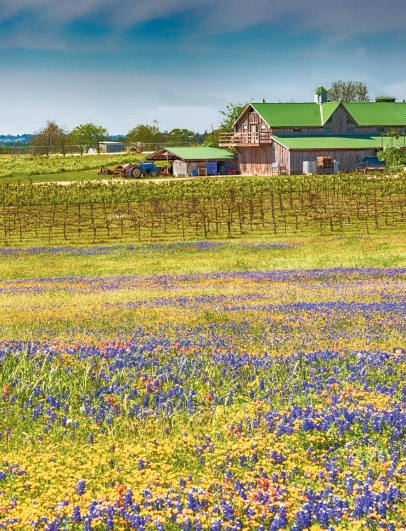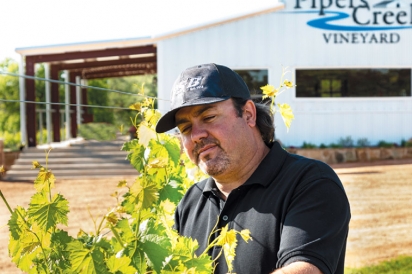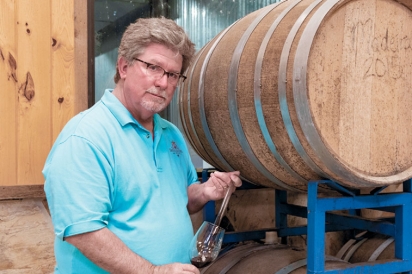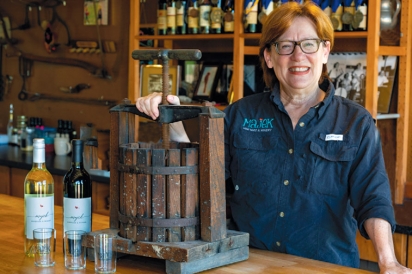A Taste of Texas Wine History
Historic vineyard region just west of Houston is undergoing a rebirth
My husband Randy’s family is Czech. They settled in the late 1800s and worked in Cat Spring. Randy’s great-grandfather, Adolph, bought the 100-acre plot for his farmstead just south of Schulenburg where our winery is now,” said Lynne Majek, co-owner of Majek Vineyards. “Winemaking was big back then; nearly all of the farmers made wine. Adolph made his red wine from native Mustang grapes and kept barrels of it under his porch to share with family and friends.”
Majek’s story of frontier Texas has been repeated many times by people whose ancestors settled here—just replace “Czech” with German, French, Italian, etc. Similar farmer-winemakers settled all around Texas right up to Prohibition.
Charles McKinney, who contributed to the reemergence of Texas winemaking in the 1980s, wrote in Vineyards in Texas—Past, Present and Future: “Texas grape growing reached a zenith by 1890 with over 3,000 acres of cultivated grapes. By 1920, with the effects of Prohibition flaring, acreage dropped to 1,000 acres and by 1972 there were only 90 acres left.” There were at least 30 pre-Prohibition Texas wineries of which five were here in southeastern Texas. These too dwindled, but Houstonians can now witness a winery rebirth about an hour’s drive west of Houston between Sealy and Schulenburg roughly following the Brazos and Colorado Rivers.
In pre-Prohibition times, prominent winemakers in this region were John Berger with his Bernardo Vineyard Winery in Colorado County and Frank Laake and his Oak Hill Vineyards Winery in New Ulm. Estimates are that Laake’s operation produced 650 to 1,500 cases of wine a year and Berger’s operation was even larger.
Many people credit the early growth in Texas’s wine industry to land impresario Stephen F. Austin. He sent pamphlets to Europe to attract European settlers. In them he said, “Nature seemed to have intended Texas for a vineyard to supply America with wines.” With his offer of land and promise of plentiful grapes, European immigrant farmers headed to Texas for a new start including a wine culture that was already part of their everyday life.
However, the grapes that Austin witnessed were not European Vitis vinifera (wine) grapes, but rather native American grapes. They grew wild along rivers and bayous, in and over trees and brambled from tight cracks in limestone. According to TAMU Associate Professor & Extension Horticulturist Jim Kamas: “From Houston to the hill country, native Mustang grapes are king, still seen today on roadside fences. To the east, it’s Muscadine.”
In the late 1800s, grape horticulturalist Thomas Volney Munson of Denison—the acknowledged Grape Man of Texas—brought Texas worldwide acclaim when he recommended native Texas grapes to a French delegation seeking a first success in their battle against the vineyard disease Phylloxera, one of the largest-scale agriculture disasters on record. Munson chose Texas native varieties—Vitis berlandieri, cinerea and cordifolia—for rootstock on which to graft European grape varieties. This success brought Munson the Chevaliers du Mérite Agricole in the French Legion of Honor, France’s highest civilian honor. Today, nearly all grapevine rootstocks used worldwide rely heavily on native Texas grape species.
In southeastern Texas, European wine grapes (Vitis vinifera) are particularly sensitive to another malady called Pierce’s Disease (PD). It was PD that killed the European grapevine cuttings brought to Texas by European settlers, prompting some to substitute native Mustang grapes for their wine needs. Others grew hybrids: Black Spanish (aka Lenoir) grapes to make red wine and Herbemont for a white wine.
Authorities say Black Spanish was an unexpected cross between native Vitis aestivalis grapes and a European Vitis vinifera (Cabernet Franc) that occurred in the 1700s on the East Coast and traveled westward. Today, Black Spanish is the highly disease-resistant red grape of choice in many Gulf Coast vineyards and most plant Blanc Du Bois, a more recent white hybrid developed for hot, humid regions like ours, created from native Vitis aestivalis and Golden Muscat (another European vinifera).
Stephen Morgan, owner/winemaker at Saddlehorn Winery in Burton says, “Blanc Du Bois makes a great white wine that is a real shining star for our state. Black Spanish makes excellent Port-style wines and we are now making strides with it as dry red table wines and blends. They’re gaining quite a following.”
Cat Spring grape grower Jerry Watson summed things up: “In 1988, I started growing grapes just west of Sealy. There were only three of us with vineyards and only two wineries in the region. With our region’s winemaking legacy, I wished then that I would live long enough to see 10 wineries between Houston and Bryan. Well, we’ve surpassed that. These wineries make for a nice day or weekend trip, offering a pleasant wine experience with a taste of history, too.”












